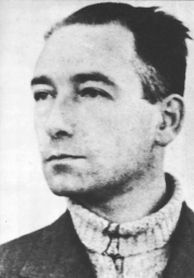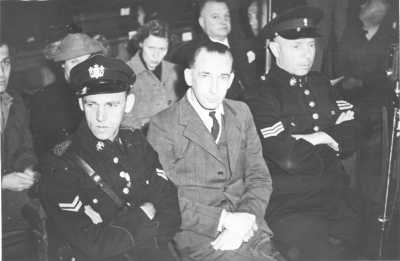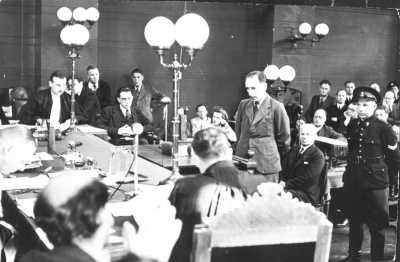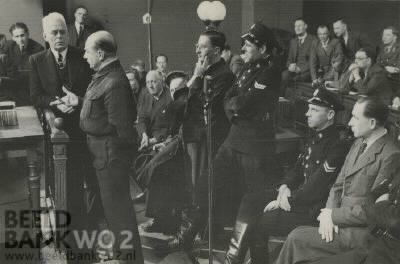Anton van der Waals (1912-1950)
Introduction
Anton van der Waals was one of the Netherlands’ most infamous collaborators. As a V-Mann (intermediary agent) of the SD (Sicherheitsdienst, intelligence agency) he infiltrated various resistance groups from 1941 onwards. He indirectly played a role in the Englandspiel, a large-scale operation of the German contra-intelligence (Abwehr) with the aim of misleading the enemy. Although there were already doubts in 1941 among resistance groups over Van der Waals’ trustworthiness, he was able to continue on his destructive path through the resistance. While pretending to be a British agent, he was able to build the trust of unsuspecting resistance members and even certain prominent leaders. Anton van der Waals was exceptionally skilled at duping people, moving freely through all sorts of groups, arousing no suspicion. This made him the ideal V-mann. Most of the Dutch resistance existed of well-meaning amateurs who operated mainly in small isolated groups. Security measures were the exception, not the rule. Therefore, they were not at all suspicious of cunning agent provocateurs such as Van der Waals. He was paid royally by the SD for his treachery but would not refrain from using blackmail and deception to increase his wealth at any opportunity. In his personal life, he was just was as unpleasant and unfaithful. He was probably the only Dutch person who was at the same time, engaged to the daughter of a member of the resistance and to the secretary of an SD chief.
Pre-war years
Anton van der Waals was born on 11th October 1912 in Rotterdam as the youngest child of four. His father owned a painting company. As a child, his parents saw him as gifted. He achieved reasonable grades and had a talent for technical subjects. After primary school and two years of secondary school, he found modest work at companies in Rotterdam. His two attempts to study at a technical school were abandoned after a few months. In the early 1930s, Van der Waals, now receiving state benefits, tried and failed to start his own company repairing radios and motorbikes. His personal life was also unsuccessful; in November 1937 he married for the third time.
In the same year, he finally succeeded in finding work as an electrician at an electric company in Rotterdam. He was often at the harbour in Rotterdam to assist in the construction and maintenance of electrical installations in submarines and other military vessels. Through working at the harbour, he learnt to speak reasonable German and English.
On the Sicherheitsdienst payroll
During the occupation, Van der Waals, an opportunist, finally got the chance to develop his talents. He had somehow come to possess two technical inventions, an improvement for radios and a crank-shaftless internal combustion engine. He tried to sell these to the resistance, the NSB and the German army with little success. Through his employer, he came into contact with a group of illegal workers at the engineer and food manufacturer, Ary van der Meer. They were prepared, at the end of 1940, to transport his inventions to the allied forces for free. Van der Waals was already working sporadically as an informer for the SD. At the end of April 1941, he reported to the SD headquarters in The Hague saying that he knew the culprit of the recent murder of a German soldier in Haarlem. Criminal director, Joseph Schreieder immediately saw the potential of the cunning and adept Van der Waals as a V-mann. When Van der Waals gave Schreieder the tip-off and helped hunt down a spy network that revolved around Josef Klingen in Heemstede, the chief of the contra-intelligence gave him a permanent job.
First results
Van der Waals had a good start as a V-mann. He knew how to win the trust of different resistance members who often voluntarily provided him with useful information. After the arrest of the resistance worker, Jan Kwak in May 1941, which was initiated by Van der Waals, he began to arouse suspicion. Ary van der Meer and a policeman in Rotterdam, Jan van den Ende, hatched a plan to murder him. However, just before they could carry out the plan, Van den Ende was arrested. Van der Waals subsequently became more cautious and constantly changed his identity and location. To avoid arousing suspicion among the resistance, the SD arrested him whenever he happened to be present during an arrest.
At the end of 1940, Van der Waals was able to gain contact with the anti-German Mayor of Rotterdam, Oud. Van der Waals convinced him that his arrest was imminent and advised him to flee to England. At the SD they saw the possibility for a Spiel. Via Oud’s connections, Van der Waals could infiltrate groups in London and even be trained as an intelligence agent by the Allies. In the end, Oud had second thoughts and the plan was not carried out.
Pawn in the Englandspiel
An operation that Van der Waals played a role in was the so-called Englandspiel. In the summer of 1941, the SD tracked down an illegal radio transmitter in a shed in Bilthoven. That is where they found a list of names of people who collaborated with two signallers. Van der Waals was put to work. He made contact with these people and several arrests followed. Even more radio operators who were dropped in from London, fell into the hands of the SD who had gained insight into the methods of the agents. A first agent was forced to signal to London that everything was fine. The plan worked, partially because London systematically ignored the absence of the agreed security check. This connection with London was exploited by the Germans to great success. An endless stream of airdropped saboteurs and supplies fell into the hands of the SD between 1942 and 1943. Van der Waals was present at the arrival of the parachutist, George Jambroes and at the rounding up of a group of resistance workers around radio operator, Tom Navis. A large-scale arrest occurred in a house in Ede after Van der Waals lead a group of unsuspecting resistance workers into the house one by one, where they were overwhelmed by an SD team.
Infiltration of the Vorrink group
At the end of 1942, Van der Waals became the leader in a new Spiel. He was able to gain the trust of socialist politician, Koos Vorrink, the key figure of the Nationaal Comité, a resistance organisation, and therefore involved in all sorts of resistance activity. Using his knowledge of the resistance and the British intelligence service and his radio contact with London, Van der Waals was able to win over the majority of the Vorrink group. He even got engaged to the daughter of Vorrink's right-hand man, Van Looij. For months, in an atmosphere of conspiracy and confidence, plans were hatched and spy information was collected. Van der Waals concluded that the invasion was imminent. The group of resistance workers around Vorrink had to make preparations for sabotage activities. In April 1943, the SD decided that it was time to gather up the Vorrink group. Van der Waals played the role of an arrestee. In the aftermath of the arrests, the rest of the Nationaal Comité and at least 150 other people on the fringes of the Vorrink group were also arrested.
Theatrics
As well as the stunt with the Vorrink group, Van der Waals 'achieved' even more in early 1943. He infiltrated resistance group after resistance group and lent his services to a great number of arrests. The SD was so pleased with his work that he was given an official award. Financially speaking, he was now a very wealthy man. The downside to his success was that his name and reputation was increasingly known among the resistance workers. Van der Waals had become too (in)famous to do his work. The SD thought of a plan to confuse the resistance workers. A fake assault on Van der Waals was performed and a message was published in the paper that he had died. However, the resistance saw right through this act of theatre. SD chief, Schreieder, decided that Van der Waals could be put to better use in the neutral Sweden. He had to save the Englandspiel that was in danger of failure. Schreieder hoped to discover the allied invasion plans through the Spiel but two arrested agents had escaped to England and so the Spiel was in danger of being revealed. Van der Waals had to convince the Dutch intelligence agency in Sweden that they were suspect. Yet the trip turned into an utter failure and Van der Waals returned empty handed. Since there was no more work for him, he was suspended.
On the run
In the summer of 1943, Van der Waals met Corrie den Held, a naive 18-year-old girl from Wassenaar. Although he still had a relationship with the SD chief, Schreieder’s secretary, he courted her. They settled in Loosdrecht and married there too, even though Van der Waals was not officially divorced from his third wife. Quickly, life became dangerous for Van der Waals because it was easier for resistance workers who wanted to murder him to find his location. After Dolle Dinsdag (5th September 1944), the pair went into hiding on a houseboat in Aalsmeer. Van der Waals murdered his butler to steal his identity. Later, he repeated this move with another butler, Joop van der Meer.
Van der Waals tried several times, in the winter of 1944, to persuade the SD to give him work to no avail. In March 1945, Anton and Corrie escaped to the village Zuidlaren in Drenthe, where they witnessed the liberation by Canadian forces in April. Van der Waals, now the most wanted traitor in the country, reported to the British secret service in an act of desperation. The Special Counter Intelligence (SCI) thought that he was a good candidate to work for the allied contra-intelligence in Germany. Van der Waals had to infiltrate the purported post-war Nazi resistance group, Werwolf. The Dutch intelligence service was brought in to help with the disappearance of Van der Waals. In July 1945, he left with Corrie for Cologne. After two months, he joined the Soviets in Berlin, only to return to the British after a few months. They no longer trusted him and kept him locked up in various internment camps.
Arrest and trial
In the Netherlands all attempts to search for enemy number one, Van der Waals, lead to dead ends. When it was announced in 1946 that he was in allied hands, the calls for his arrest and trial became stronger. In July 1946, he was removed from a German internment camp and taken to the Netherlands. Corrie was later found in February 1947, in a flat in Berlin. However, in the end, she was not accused.
In the numerous hearings in 1947, Anton van der Waals kept mentioning the name ‘John Verhagen’. He admitted all accusations but claimed he was just following orders from a British agent who told him to go work for the SD in order to gain information about the Germans. Van der Waals could not prove the existence of Verhagen at all. During the trial, this story was considered a misleading fairytale. On 7th May 1948, the Special Court in The Hague sentenced him to death. Appeals made by himself and his family were rejected. In the early morning of 26th January 1950, the Netherlands’ most hated traitor was killed by firing squad on the Waalsdorpervlakte. Just before his execution, Van der Waals admitted that Verhagen did not exist and that all responsibility rested solely on his shoulders.
That Van der Waals could create so many victims was not only due to his talent as an agent provocateur. There was a lack of information in the Netherlands during wartime and a need to connect to London and other resistance groups. Someone who claimed to have such contacts was therefore (naively) taken seriously, even if his claims could not be confirmed. The atmosphere in the occupied Netherlands was like that of a twilight zone, where people were feeling their way through the dark. This idea was used by the author W.F. Hermans in his war novel, ‘The Darkroom of Damocles’. There are many elements that were borrowed from the life of Van der Waals. The main protagonist, Osewoudt blames his doppelganger, Dorbeck who encouraged him to commit his crimes. After the war, no one believes him and he is seen as a traitor. Dorbeck is never found and Osewoudt dies, just like Van der Waals, by firing squad. The difference is that Osewoudt, as depicted by the author, had acted on good faith. This was certainly not the case for Anton van der Waals.
Definitielijst
- Abwehr
- Term used for the German military intelligence unit during the WW1 and WW2. From 1935 onwards under command of Admiral Wilhelm Canaris. The organisation often came into conflict with other secret services such as the SD and the Gestapo. During World War 2 under Canaris frequently a source for conspiracies against the Nazi regime until in 1943 a major conspiracy by a number of prominent members of the Abwehr was discovered and the Abwehr was placed under command of Himmler. After the assassination attempt on Hitler in 1944, Canaris was discharged and the Abwehr was dissolved. The conspirators and Canaris were prosecuted and in 1945 they were executed atc oncentration camp Flossenburg.
- Englandspiel
- “England game”. The game, ironic as it may sound, of espionage and counter espionage between the British Special Operations Executive (SOE) and the Nazis. This “game” resulted in the death of approximately 54 allied spies.
- invasion
- Armed incursion.
- Nazi
- Abbreviation of a national socialist.
- NSB
- National Socialist Movement. Dutch political party sympathising with the Nazis.
- resistance
- Resistance against the enemy. Often also with armed resources.
Images
 Anton van der Waals, one of the Netherlands’ most infamous collaborators. Source: Beeldbank WO2.
Anton van der Waals, one of the Netherlands’ most infamous collaborators. Source: Beeldbank WO2. Van der Waals during the trial against him in The Hague. Source: Beeldbank WO2.
Van der Waals during the trial against him in The Hague. Source: Beeldbank WO2. Another picture taken during the trial against Van der Waals. Source: Beeldbank WO2.
Another picture taken during the trial against Van der Waals. Source: Beeldbank WO2. Joseph Schreieder, during the war an SD-employee, act as a witness during the trial against his former employee Van der Waals. Source: Beeldbank WO2.
Joseph Schreieder, during the war an SD-employee, act as a witness during the trial against his former employee Van der Waals. Source: Beeldbank WO2.Information
- Translated by:
- Rachael Darwin
- Published on:
- 19-01-2025
- Feedback?
- Send it!
Sources
- JANSSEN, F.A., Over De donkere kamer van Damokles van Willem Frederik Hermans, Arbeiderspers, Amsterdam, 1976.
- KOK, A., De verrader: leven en dood van Anton van der Waals, Arbeiderspers, Amsterdam, 1995.
- VISSER, F., De zaak Antonius van der Waals, Zuid-Hollandsche Uitgeversmaatschappij, Den Haag, 1974.



